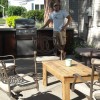Old Home and Unstable Floors
I fell in love with the cottage of my dreams but the floors are unstable. We retained an expert before we put in a bid on the house. Has anyone else hired a structural engineer and shored up the footings of an old house?
This one is from 1855. I understand my husband's concern and we are doing the needed research but how much of a headache am I in for?Probaby a lot, usually in fixing one problem, they find 10 more. I hope it doesn't end up like that, but be careful. But when everything is done, remember, it will be the house of your dreams.
I perform a lot of renovations of this nature. If you take pictures of the floor and the underlying structure, I can give you a rough idea of what you are looking at in terms of cost and appropriate methods.
The instability in the floors in a home of this age is not uncommon. But the term “unstable” doesn’t exactly describe the issue. Are they “bouncing” or “out of level” or deteriorating? Are they wood or suspended aggregate or both? Are they on grade or raised?
I can perhaps give you a bit more assistance if you describe in more detail the issues and or the engineer’s findings.The rooms vary in height as described by the structural engineer - there is zero, there is plus one, there is minus one.
The minus one probably will be demolished and the "addition" added there.
The crawl space is difficult for him to navigate so he is returning to scout it out in more detail.
It doesn't feel unstable it looks unstable when you look and compare the floors from room to room.It sounds as though the home is timber frame and built on a series of piers or a combination of sills and piers. This issue appears to be that of nothing more than settling
I am going to assume the “height” you are describing is the difference in floor level, zero being the chosen benchmark applied and plus one and/or minus one being 1 inch above and/or one inch below the selected benchmark point and leveling is the issue.
If this is the issue the repairs are actually quite minimal and can be accomplished by jacking and shimming.
However something in your description sounds suspect to me, a one-inch variance is not that severe nor would it commonly be observed by the untrained eye or even felt depending upon dimensions of the rooms. (The larger the room the harder to discern.)
It very well could be the original benchmark was the plus one (high point) and the home has “settled” in varying degrees to a maximum of minus two.
The points that must be benchmarked (zero) are the exterior foundation corners. If these are all even then the house is sagging in the center and the piers need to be based or jacked and shimmed. If the corners are uneven the house is leaning and the sills need to be leveled and perhaps the piers addressed as above.Wow! I spent 2 hours with the engineer and learned more from you! Thank you very much!
I believe and I am only guessing the differences are mainly "additions". We spoke with the owner but she stated everything was original but I would guess from your clear description that the center (point zero) was built and then the rooms to each side added.
Luckily the house appears not to be sagging - perhaps just poor additions. It will be interesting to see the structural engineer's bid.
Thank you so much - you are a great help!- Dave Framerposted 13 years ago
0
I do a lot of home improvements and new homes as well,judging by the date of the house in question, they typically used large rocks otr timbers for the support, not really piers and footings that we are all accustomed to now, of the older homes we have done most of the structures were surprisingly in good shape, they mostly had settling issues.I would reccommend you go over issues with your engineer then meet with a qualified framer and discuss your options with both of them, probably just jacking up the low levels adding the required number of piers and dropped sills
Related Discussions
- 25
What's the best flooring for a home with pets, wood or carpet?
by Carson Creek 7 years ago
What's the best flooring for a home with pets, wood or carpet?Which floor is easier to live with when you have either dogs or cats, carpet or wood floors.
- 20
Would you build a house without an engineer?
by Mona Sabalones Gonzalez 2 years ago
Far too often I see people in the Philippines scrimping on expenses to build their first house by not consulting an engineer. They believe that an architect is sufficient.Do you believe a house can be built with just an architect, or would you insist on hiring an engineer too? Why?






